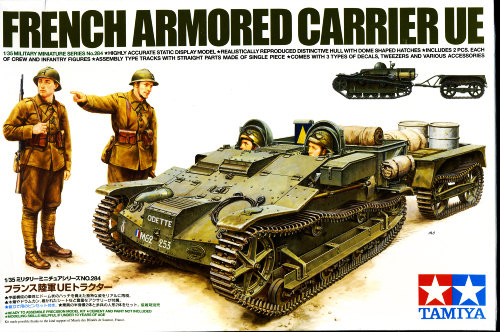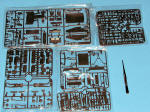
| KIT: | Tamiya 1/35 French Armored Carrier UE |
| KIT #: | 35284 |
| PRICE: | $32.00 at www.wingsntreads.com |
| DECALS: | Three options |
| REVIEWER: | Scott Van Aken |
| NOTES: | Includes four figures |

| HISTORY |
Ever since 1922 it had been the policy of the French Infantry to mechanise as many units as possible. Budgetary restraints however made it unrealistic to envisage the full equipment with armoured personnel carriers; but the mass production of smaller armoured vehicles in the roles of munition and supply carrier and weapon carrier for machine guns and mortars seemed feasible. For some years the decision to produce these types was delayed, but after in 1929 an experiment with an automotive trailer guided by a walking soldier had completely failed, it was decided to develop a single vehicle for both missions. In the spring of 1930 several possibilities were considered, among them a standard 3.5 ton truck and the existing Citroën-Kégresse half-tracks. Brandt, as such an arms producer having no experience in vehicle development, had already started cooperation with the British Vickers company to build a weapon carrier for its Brandt Modèle 1927 mortar; it proposed to produce the British Carden-Loyd Mark VI carrier in licence and presented a smaller and a larger vehicle, together with matching trailers, imported from Britain, for the supply and weapon carrier task respectively. On 24 July 1930 the Commission de Vincennes rejected the truck and half-tracks as being too heavy and opted after some satisfactory testing for the smaller weapon carrier of the Vickers type. On 7 October it was decided to develop such a vehicle under the name of Type N. Orders for prototypes were in December 1930 made with three companies: Renault, Citroën and Brandt. Renault however indicated he had no intention to pay licence rights, unless the French state would fully compensate him; the three companies were thus invited to build a "similar" vehicle, not an exact copy. The orders were for armoured tractors and matching tracked trailers and for a heavier trailer to carry again the tractor, to be pulled by a truck while the smaller trailer trailed behind.
In the summer of 1931 the prototypes were ready for trials. Citroën had received orders for six tractor prototypes: three fully tracked vehicles and three of the half-track type. The first prototype to be ready, not at all resembling the Carden-Loyd carrier, was in the form of a very small half-track fitted with a Kégresse track and manned by only a driver protected by an armoured hood with vision slits, sitting on the left side of the vehicle, with the engine to his right. Only the nose of the vehicle was armoured. It was presented to the Commission de Vincennes on 24 July 1931 and tested till 29 July. The commission noted that the cooling system failed and that there was no possibility to decouple the trailer from inside the driver's cabin. On 31 July the other two half-tracks were delivered together with the first two trailers. The matériel was rejected as being too vulnerable. Citroën discontinued the development of the fully tracked vehicles but rebuilt one of the half-tracks prototypes into the prototype of the larger AMR Citroën Kégresse P 28 half-track, fifty of which would be built.
On 10 and 17 December 1930 Brandt had obtained an order for six complete sets: tractor, trailer and tractor-carrying trailer. To honour its commitments to Vickers, it let the trailers and one tractor be built in Britain. To conform to the idea of production in France, Brandt delegated the task to build a new tractor type to the Latil company, as it had too little experience itself. The Latil prototype, presented on 7 August 1931 was very much on lines of the British type and strongly resembled the later Universal Carrier: fully tracked and with most of the vehicle covered by an open rectangular superstructure to ensure as large a carrying capacity as possible. Only a small driver's and engine section on the front was armoured on top. On 17 July the commission considered the type ready for troop trials.
The first prototype to be ready was that of Renault, that also had received orders for six sets. It was tested between 15 and 23 April 1930. Certain defects were found and remedied, after which the prototype was again tested from 3 June. A second prototype, fitted with a rubber track, was tested between 28 April and 12 May. This other track type was shown to be too weak. The project had as factory designation Renault UE, a chronological letter code without further meaning; the smaller trailer was the Renault UK. The Vickers suspension with double track guides was imitated. For Renault this new suspension type, that he patented despite its obvious Vickers ancestry, offered the solution for severe problems he had experienced trying to adapt his existing suspension models, using single track guides, to a high velocity vehicle without increasing the chance that the track would be thrown at higher speeds. Renault hoped to further develop the UE into a light tank by adding a turret; accordingly the hull resembled a tank chassis rather than a dedicated supply vehicle.
In October 1931 the Conseil Consultatif de l'Armement, under strong pressure by the Infantry to reach a quick decision, chose the Renault vehicle for production, even though the trial process hadn't been completed. On 9 December an order of fifty was made for the Chenillette de ravitaillement d'Infanterie Modèle 1931 R. On 26 March 1932 fifty tractor-carrying trailers were ordered, the first was delivered in June. Further orders followed, reaching a total of 793 on 1 January 1936, 700 of which had been delivered in June 1936. Later that year the military branch of Renault was nationalised as the AMX company which continued production to a total of about 2200, later joined by Berliet which would build another 100 and Fouga which would produce 300 for a grand total for the Modèle 31 of about 2600
In the early thirties, the French Cavalry was in need of a small scouting vehicle. On 27 November 1931, the Section Technique de la Cavalerie asked Renault to rebuild one of his six chenillette prototypes into an armed tankette. Prototype N° 77982 was therefore in the winter of 1932 turned into a Automitrailleuse légère de contact tout terrain by being fitted with a small rectangular superstructure holding in its front a ballmount with machinegun, to be operated by the commander; the hood was placed on top of it. This type was rejected by the Cavalry; further developments would however result in the AMR 33 light cavalry tank of which the Renault UE was the direct ancestor.
Renault was always very intent on procuring foreign orders, be it normally without much success. To improve the attractivenes of his Renault UE he also offered a version with a machine-gun. In March 1936 the government of China placed on order for ten Renault UEs armed with machine-guns, together with twelve Renault ZB tanks. Though the tanks eventually reached China in 1940, the chenillettes were held up in Haiphong from 1938 because France gave in to Japanese pressure; they appear to have been confiscated in 1940 by the French authorities of Indo-China. Including these export vehicles, total French Renault UE production was thus about 5158.
During the Battle of France, in May 1940 the swiftly deteriorating situation led to an order being issued to arm all available tracked chassis and send them to the front. This included the available FT-17 hulls from which the turret had been removed to to turn them into utility vehicles, the Renault ZT 4s that not had yet received their turrets — and also the Renault UE Modèle 37s produced from that moment. About a 150 of these were thus fitted with a MAC 31 "Reibel" machine-gun.
| THE KIT |
 As
one would expect from Tamiya, the molding of the kit is superb. No sink areas,
no flash and what ejector pin marks I saw, which were considerable, should be
hidden away once the model is built.
As
one would expect from Tamiya, the molding of the kit is superb. No sink areas,
no flash and what ejector pin marks I saw, which were considerable, should be
hidden away once the model is built.
There is no interior as such with the driver and helper's compartment filled with half figures. In fact if one does not use the figures, then some scratch-building will be needed as all one will see in the driver's area without them is a flat pedestal.
Suspension is nicely done and one does have to paint
rubber on the road wheels and return rollers so painting will be one of those
done in stages as construction goes along as they will be quite visible. Tracks
are of the separate links and runs variety with the upper sections molded with
sag in them. There are a few differences in what is put on the vehicle depending
 on the markings option used and
that is clearly shown in the instructions.
on the markings option used and
that is clearly shown in the instructions.
The kit also includes the tracked trailer which also has sectional tracks. A goodly number of bins, boxes and barrels are included to help fill up the back of the carry-all and the trailer. Two additional figures are provided as shown on the box art. The instructions are very well done and show all the painting needed. Of course, it is only Tamiya paint references so mixing will be required to match some of the paints. No generic names are given for the mixed paints, which is shame as not everyone likes Tamiya paints so you are on your own in that regard. The small decal sheet is well printed and should provide no surprises. This kit also included a pair of stamped steel tweezers. Not exactly precision, but it is a nice thought and will come in handy for this build.
| CONCLUSIONS |
I am glad to see Tamiya doing these sorts of kits. One could say that the armor field is already saturated with what some call 'Germans and Shermans', so seeing French equipment is a breath of fresh air. I'm sure this one will be well received and is the sort of thing that attracts those tired of doing the same old stuff.
| REFERENCES |
September 2007
My thanks to www.wingsntreads.com for this one. Get yours on-line at a nice discount.
If you would like your product reviewed fairly and fairly quickly, please contact the editor or see other details in the Note to Contributors.